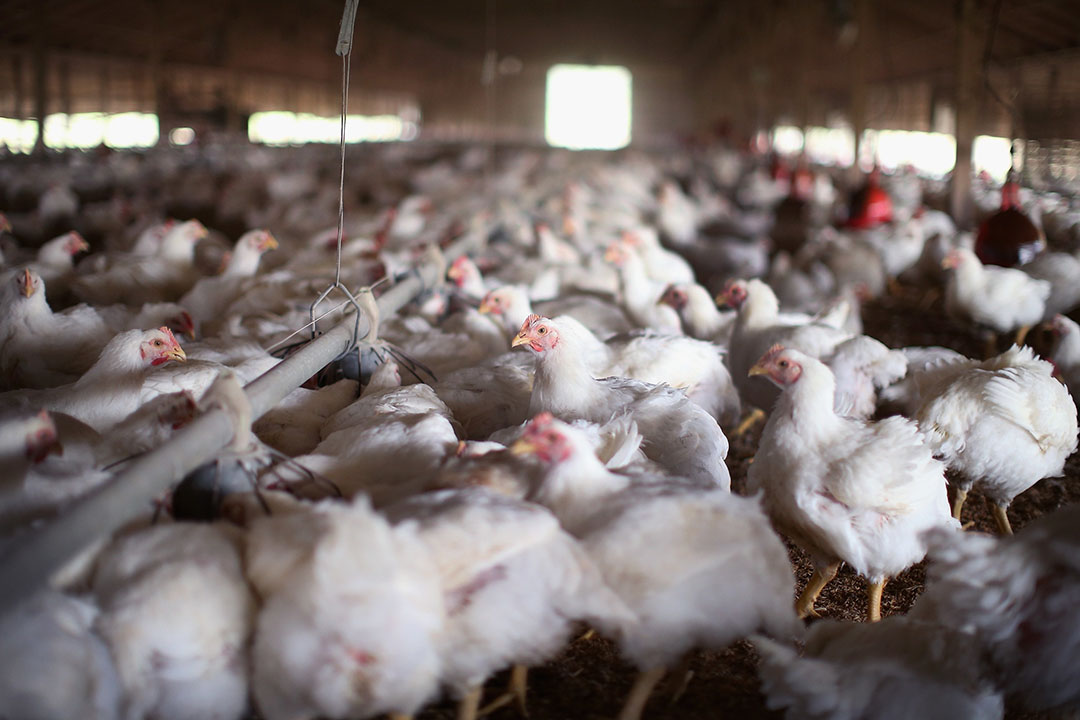The nutritional needs of slow-growing birds

Improvements in genetics, management and nutrition dramatically improved the speed at which today’s farmers can produce poultry meat. And while demand for inexpensive protein remains high, demand for slower-growing breeds is on the rise. But what implications does this have on poultry diets?
Driven by animal welfare concerns, and the slow food trend, which prizes taste and quality, this growing niche provides new opportunities for broiler farmers. Researchers and breeders work to formulate diets to help producers find diets that take into consideration new management guidelines, minimum age of slaughter and maximum daily growth rates.
Differentiation in the marketplace is not new, but it’s driven by different factors in different regions. France, for instance, tends to focus on tradition and cuisine, while Southern and Eastern Europe focus on traditional and sometimes seasonal backyard markets. Schemes in northern European countries, like the UK, the Netherlands and Germany, tend to be driven by animal welfare.
US retailers push for change
In the United States, more chicken is consumed than any other type of meat. According to the National Chicken Council, in 2015, Americans consumed 9 billion broiler chickens and 40 billions pounds of chicken meat. In order to keep up with demand, the industry had to figure out how to produce chicken quickly, efficiently and more economically. And figure it out they did. Based on data from the National Chicken Council, chickens in 1955 were marketed at 70 days of age at an average weight of 1.63kg. To get to this weight, they required about 3kg of feed for every 1kg of gain. The same data shows vast improvement some 60 years later. On average, in 2015, chicken could be grown to 2.81kg in just 48 days with a feed conversion ratio of 1.89. But with rapid weight gain came changed conformation with much of the meat shifting from the lower to upper body.
In 2016, Whole Foods Market and Global Animal Partnership (GAP), a non-profit organisation that develops farm animal welfare standards in the US, announced that they would be switching to slower-growing breeds by 2024. The announcement spurred similar pledges from other major retailers across the US, as well as research projects evaluating how the new guidelines would impact management, particularly with regards to nutrition.
University of Kentucky researcher Dr Tatijana Fisher published a paper on the subject, entitled ‘Management of slow growing broilers for profit.’ In it she writes: “While GAP’s announcement suggests the only difference between a slow-growing broiler like the Red Ranger and the fast-growing broilers used commercially is 23% slower growth, this fails to account for the implications of the other differences. Most notably, the poorer feed conversion, lower WOG (without giblets) yields, and lower breast meat yields.”
Implications of shift to slow-growers
Fisher’s paper raised concerns about breast meat, the most highly sought after part of the broilers. While the Cornish Cross carcass, she said, produces over 30% breast meat, the Red Ranger carcass is only 20%. Further calculations show that in order to produce the same amount of breast meat, 9% more birds will be needed. To account for the combination of more birds and longer rearing times, 50% more housing will be required, as well. Finally, to account for the increased number of birds and longer grow-out, 128% more houses will be needed, as well as 97% more feed.

Efficient ways are continuously being sought to maintain both the health and performance of birds. Check out the Poultry Nutrition Special
Fisher also conducted self-selection feeding trials that compared growth performance of Red Ranger (slow-growth) to Cornish Cross (conventional). Birds were housed on the floor in groups of 25 in a standard system, and were offered 4 choices of feed: a protein concentrate that contained all of the necessary vitamins and minerals, cracked corn, pearl millet, and rolled naked oats. They were then monitored over 20 weeks to see what they ate. Based on consumption, the researchers then calculated average energy intake.
Fisher’s findings show that while Red Ranger was cheaper to feed on a day-to-day basis, the cost to feed long-term was much higher. In terms of growth performance, the Cornish Cross had a higher average daily gain than the Red Ranger, which was not surprising. “We have about a 1.9 feed conversion on the Cornish Cross, which is not the best you can get off them,” she said. “The Red Ranger had about a 2.2, which is downright awful on some level. Still it was better than some heritage breeds, which have a feed conversion rate of about 5.0,” she added. Fisher said more research is needed to look at other parameters, including nutrient requirements, meat quality and behaviour.
Exploring the nutritional needs
In Belgium, Dr Evelyne Delezie, a researcher at ILVO (the Institute for Agricultural and Fisheries Research), found that slower growing birds have different nutritional needs. Slow-growing broilers can be raised on diets that are lower in digestibility. Producers can also lower protein and amino acid levels without impacting performance, she said. “The main conclusions from published research are that it is only possible to make a small downwards adjustment to the energy content of slow-growing broilers diets, as their feed intake is lower in the first place,” she said at a poultry conference in 2018. “They do need a certain amount of energy, so you can’t lower that too much.”
The Ross breed reached its target weight of 2.5kg in just 40 days, whereas the slower-growing Sasso breed took 62 days to reach the same weight. Over their lifetime, feed intake was 40–50% higher for slower-growing breeds, and overall body weight was 50% lower. When carcass composition was compared, the slower-growing birds had a higher percentage of leg meat and a lower percentage of breast meat. “My opinion is that those animals have better welfare, but it’s not sustainable if you look at the efficiency of those animals,” she said.

Geographical differences in systems
Dr James Bentley, senior nutritionist at Hubbard, said there is no one-diet-fits-all solution when it comes to slow-growing breeds. “It’s quite a wide field, actually, because there’s so many different systems of slow-growing production,” he said. “If you go from Norway in the north of Europe all the way down to Spain, Portugal – even into Africa – there’s different slow-growing systems and breeds being used, and they all vary. They all have some specific characteristics about them, which makes it difficult to produce general nutrition recommendations.”
In fact, across Europe, the individual systems provide very specific guidelines on minimum age at slaughter, maximum growth rate levels, housing systems, husbandry practices and phenotypes. The first course of action is to choose the right genetics, followed by nutritional planning to meet the breed’s specific needs. According to EU Poultry Meat Marketing Regulations, Traditional Free Range, for instance, raises slow-growing breeds to a minimum of 81 days. Birds under these systems must be fed a diet that consists of no less than 70% cereals. In the barn, there can be no more than 12 birds per m2, and access to the outdoors is required from six weeks of age where the ranging area must be at least 2 m2. Finally, there can be no more than 4,800 broilers in one house.
In the UK, RSPCA introduced new welfare standards in 1996 where the welfare of a breed is assessed according to the RSPCA Broiler Welfare Assessment Protocol. Under the RSPCA Assured scheme only certain breeds may be raised. Accredited breeds currently include Hubbard’s JA757, JA787, and JA987, as well as Aviagen’s Ranger Classic, Ranger Gold and Rambler Ranger. In 2006, the RSPCA welfare standards for broilers restricted genetic growth rate to 45g/day. In 2013, welfare standards changed from permitting a maximum genetic growth rate per day, to requiring slow-growing breeds to be independently assessed according to the RSPCA broiler welfare assessment protocol. The JA757 is the control bird in this protocol and, as such, is not subjected to re-testing every 8 years.
Variable system requirements
Some producers are making the switch from faster growing to slow growing breeds, but do not fall under a specific scheme. “In general, what we find is that most of those systems will be using lower amino acid content diets,” said Dr Bentley. Before offering nutritional advice, Dr Bentley will first look at whatever accreditation scheme the producer works under. He’ll look at everything from breed to minimum age of slaughter to target weight at that minimum age.
“With the slow-growing systems, most of them have a minimum age or an age range,” he said. “Free-range is 56 or 81 days, so whatever your target weight is you’ve got to be 56 or 81 days. Some may be 2.1kg, some may be 2.3, some may be more,” he continued. “In addition to the system itself that’s a variable that you have to take into account because the heavier you want to be, the more protein you may need just so that they grow a bit faster – or you may need to slow them a little bit down with less protein.”
In free-range systems where birds are being grown out to older ages, most producers will use lower amino acids because these birds need more energy for maintenance and activity. Organic producers tend to use even lower amino acid levels. “It’s kind of a progressive step down in amino and protein levels from the standard bird,” said Dr Bentley. “Sometimes if people are growing the slow-growing breeds without any constraints in their systems, they say the logistics of making diets for fast-growing birds and the slow-growing birds is an issue, and they may decide to feed the fast-growing birds’ diet to the slow-growing breeds as well. But that’s normally overfeeding them protein and amino acids, which is costing them money,” he added.
Some certification systems require a minimum number of cereals as well, he said, pointing to France as an example, which limit the amount of protein or energy you can put in the diet. In free-range systems, Dr Bentley said some farmers vary the physical quality of the feed, switching from pellets to mash as needed. While there isn’t a change in the actual formula, the change in physical quality can slow or speed up feed, leading to a weight variation of 150-200 g.
Given the variety of schemes around the world, it is just not possible to provide specific nutritional advice. Recommendations need to be tailored to the different broiler concepts, taking into consideration housing type, minimum age of slaughter, target weight and breed. And while there is lots of research on fast-growing breeds, Bentley concedes that more research is needed on the nutritional needs of slow-growing breeds. “So, there is a bit more trial and error of getting it right with individual producers as we go along,” he concluded.











